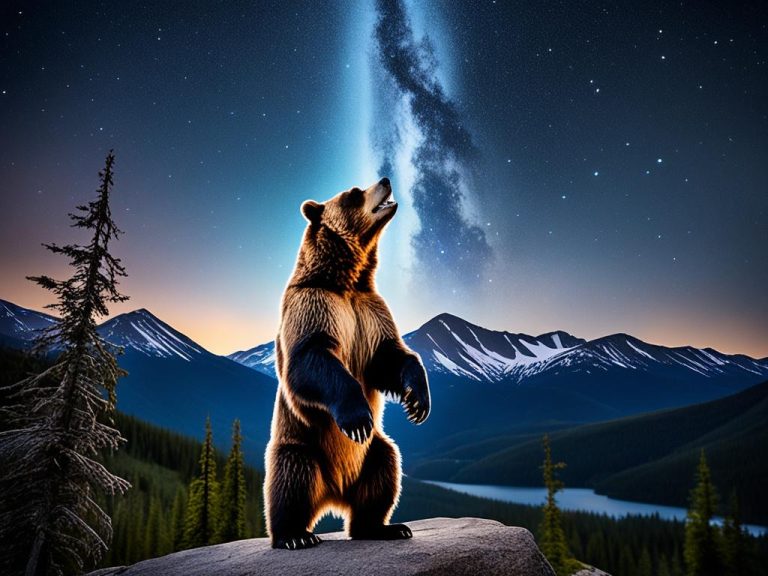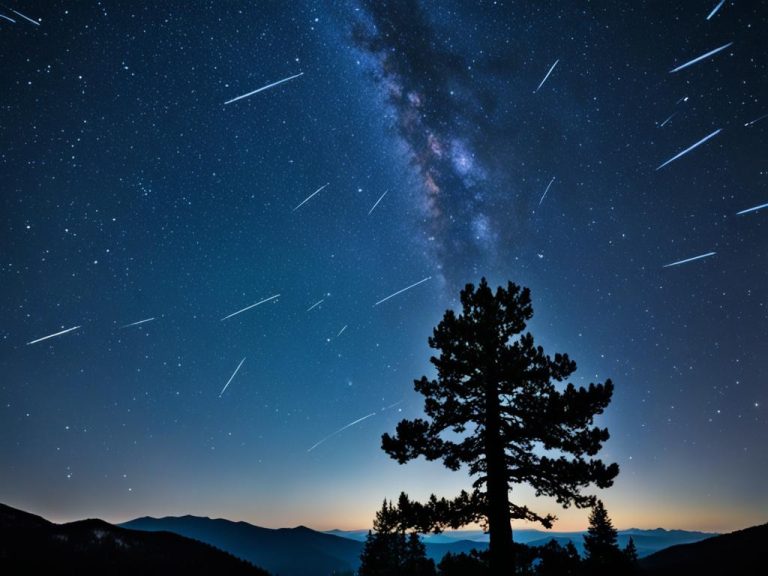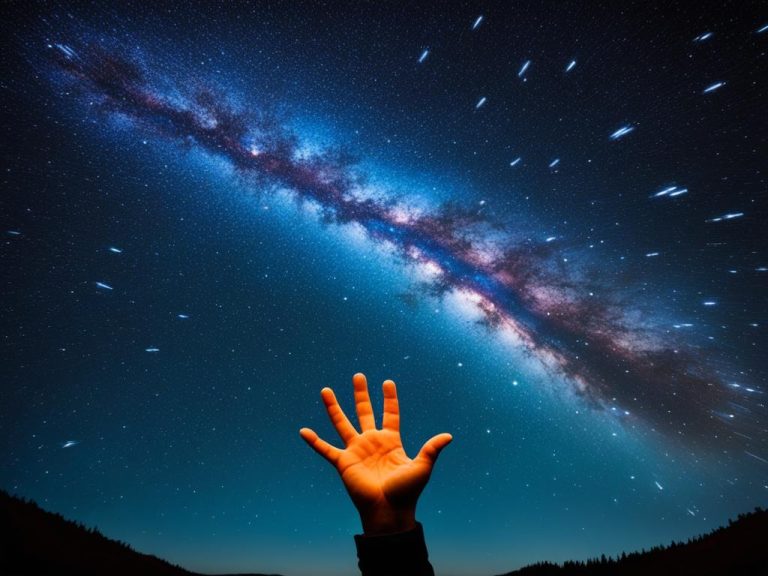Explore the Ursa Minor Constellation Secrets
Did you know the Ursa Minor Constellation is called the Little Bear? It helps people travel all over the world. This small group of stars in the sky’s north has Polaris, the North Star. It guides sailors, explorers, and adventurers for many years.
The Ursa Minor looks like a bear with a long tail. It has seven main stars, including Polaris. Stars like Kochab and Pherkad are also there. They make up the “Guardians of the Pole.” They add to the constellation’s beauty.
Are you into staring at the stars, learning about old stories, or interesting myths? You’ll love learning about the Ursa Minor. It has stories from ancient Greeks to Native Americans. This makes it very special and fascinating.
Key Takeaways:
- The Constellation Ursa Minor , also known as the Little Bear, is located in the northern celestial hemisphere.
- It contains the North Star, Polaris, which has been crucial for navigation.
- The constellation is shaped like a bear with a long tail and is composed of seven main stars.
- Kochab and Pherkad are notable stars that form part of the “Guardians of the Pole” asterism.
- Ursa Minor has a rich mythology from cultures around the world.

The Mythology and History of Ursa Minor Constellation
Ursa Minor is the Little Bear in the night sky. It has stories from Greek and Native American cultures. One Greek tale is of Callisto and her son Arcas. Zeus turned them into bears to save them. They became the stars Ursa Major and Ursa Minor, which includes the Little Dipper’s stars.
In Native American stories, Ursa Minor is a cub chased by hunters. It shows the balance between nature and humanity.
For centuries, people used Ursa Minor for finding their way. The North Star, Polaris, is in Ursa Minor. It helps travelers know which way is north because it hardly moves in the sky.
By knowing the stories of Ursa Minor, we learn more about the stars above us. People in the past and present have found inspiration and direction from this constellation.
The Significance of Ursa Minor in Astronomy
Ursa Minor is also known as the Little Bear constellation. It’s very important in astronomy because of Polaris, the North Star. For ages, Polaris has guided travelers and sailors across the world.
The North Star stands out at night because it doesn’t move. While other stars appear to circle it, Polaris stays still. This makes it a key point for finding your way, either on land or at sea.
Ursa Minor is related to the Ursa Major group, which has famous constellations. These include Coma Berenices, Boötes, and Draco. Ursa Minor itself is not that big, ranking 56th in size out of 88 constellations.
In Ursa Minor, five stars are clearly named. These stars are Baekdu, Kochab, Pherkad, Polaris, and Yildun. Polaris is the brightest, standing out with a bright light. It’s a pulsating giant star, much bigger and brighter than our Sun, and is around 431 light years from Earth.
Polaris isn’t just important for finding directions. It’s also fascinating for astronomers. They study the stars around it using images like star trails. Many cultures have their own stories about Polaris, adding to its special meaning.
Want to know more about Ursa Minor and its stars? Check this website. You can also learn about Polaris’s navigation role at this resource. Or explore Ursa Minor on Wikipedia.
Naming a Star in Ursa Minor
Naming a star in Ursa Minor is a timeless tribute. It lets you make a memory for yourself or a loved one that lasts. International Star Registry offers you a chance to name a star after someone special. This unique gift is perfect for birthdays, anniversaries, or to show your love and thanks. It’s a present that will always be treasured.
International Star Registry has offered star naming services since 1979. When you buy a star for someone, you get a real star name that’s yours forever. You also get a certificate and star map, making it easy to find your star in the sky. This makes your star gift even more special and personal.

Looking for a heartfelt gift or a unique way to mark a special time? Naming a star in Ursa Minor with International Star Registry is a great idea. It shows love, thankfulness, and the awe of the night sky. Name a star today and make a beautiful, everlasting memory.
Ursa Minor: A Delight for Stargazers
If you love looking at stars, Ursa Minor will make you happy. It’s also called the Little Dipper. You can see it from Ireland all year. It’s easy to find in the northern sky. Its shape and story are interesting to see at night.
Ursa Minor has seven not so bright stars. Each star is special in its own way. The North Star, or Polaris, is the brightest. Sailors have used it for direction for a long time. It’s a big yellow star about 430 light-years from us.
Other cool stars are in Ursa Minor too. The second brightest star is Kochab, an orange giant, 126 light-years away. Pherkad, the third brightest, is blue-white and 487 light-years away. Yildun, the fourth, is yellow-white and 103 light-years from us. Epsilon Ursae Minoris, the fifth, is a pair of stars 304 light-years away. Zeta Ursae Minoris, the sixth, is a group of three stars 380 light-years away. Finally, Eta Ursae Minoris, the seventh, is a double star 97 light-years from here.
If you like space, Ursa Minor is a good one to see. It might not be the brightest but it’s still special. It’s perfect for admiring the sky or learning about stars.
For more info on Ursa Minor and other stars, visit stargazingireland.com. You can also name a star there with International Star Registry. It makes a great gift for someone special or a special event.
Ursa Minor from Ireland: A Guide to Viewing
Are you in Ireland and want to explore the night sky? Ursa Minor is always up there for you to see. It’s great for both new and experienced sky watchers. You’ll be amazed by what you find.
To see Ursa Minor from Ireland, head away from city lights. Look for a place with a wide, clear view north. The best time is summer when the sky is dark and the stars shine bright.
When looking at Ursa Minor, you’ll see two special stars at the tip of the Little Dipper’s handle. They’re called the “pointer stars” because they point right to the North Star, Polaris. Polaris doesn’t move and can show you which way is north.
Using binoculars or a telescope can make Ursa Minor even more exciting. They bring the stars closer and show you more details.
So, get your binoculars or telescope, pick a quiet spot under the Irish night sky, and start your adventure with Ursa Minor. You’re up for an experience that’s both beautiful and thought-provoking.
The Mythology of Ursa Minor
The stories around Ursa Minor are full of wonder. Cultures worldwide have tales about this constellation. These stories have been shared for many, many years.
Greek myths tell us about Callisto and Ursa Minor. Zeus turned her into a bear to protect her. Then, he put her in the sky with her son. They are the bears we see today.
In Norse tales, Ursa Minor is Odin’s Chariot. Two goats pull it across the sky. Odin travels on this chariot, watching over everything.
Hindu myths connect Ursa Minor with Dhruva, a prince who became a star. His strong faith made him the North Star. Ursa Minor represents his story of courage.
These myths make Ursa Minor even more fascinating. They have intrigued people for centuries. Even today, they capture our imagination.
Ever thought about the stars’ stories? The myths of Ursa Minor are a wonderful look into our past. They show how our cultures shared stories through the stars.

The Stars of Ursa Minor
Ursa Minor is the Little Bear or Little Dipper in the sky. It’s in the north and has seven main stars. People have looked at these stars for many years, feeling amazed by the vast universe.
The North Star, also known as Polaris, is the brightest in Ursa Minor. It’s important for finding direction because it shows where North is. That’s why it’s called the “Guiding Star.”
Kochab and Pherkad are close to Polaris. They are called the “Guardians of the Pole.” They help people find the North Star.
Other stars in Ursa Minor include Yildun, Epsilon Ursae Minoris, Zeta Ursae Minoris, and Eta Ursae Minoris. Even though they look faint, you can see them in a dark sky. They make up the Little Dipper, making Ursa Minor a wondrous sight.
Looking at Ursa Minor makes us feel part of something big. These stars show us the beauty and wonder of space.
Deep Sky Objects in Ursa Minor
Ursa Minor is not famous for deep sky objects, but there are a few gems to discover. For example, there’s NGC 3172, a small spiral galaxy. It’s found about 1 1/2 degrees southeast of Polaris. This galaxy, with a magnitude of 14.9, shows us a bit of the huge universe.
Then, we have NGC 6217, a barred spiral galaxy, making Ursa Minor more interesting. Its unique shape and brightness make it a must-see for telescope fans.
The Ursa Minor constellation also holds the Ursa Minor Dwarf, a dwarf galaxy, for extra excitement. Even though it’s small, it adds to the variety of galaxies in our universe.
NGC 6251, an active supergiant galaxy, is another find in Ursa Minor. With its size and activity, it’s an exciting target for scientists studying the stars.
These objects may not be as well-known, but they let observers dive into the wonders of Ursa Minor. We can still find beauty and mystery by exploring these celestial points.
Want to know more about Ursa Minor and its deep sky objects? Visit Sea and Sky, The Sky Live, and EarthSky.
Conclusion
Ursa Minor is a fascinating constellation loved all over. It has great stories and helped sailors find their way. We know it as the Little Bear or the Little Dipper. This group of stars is dear to our hearts, especially at night.
Naming a star in Ursa Minor through International Star Registry is a special star gift. You can put someone’s name in the stars forever. This gift is unique and shows your love in a memorable way. It will keep shining for years to come.
Looking at the stars in Ursa Minor, we find beauty and awe. It’s a wonderful way to remember loved ones. These stars show us how amazing the universe really is. Let them be a part of your connection to the sky.
Explore Ursa Minor to find out its intriguing tales. The night sky calls to us with its mystery and joy. Ursa Minor can be our guide, reminding us of endless wonders in space.
FAQ
What is the Ursa Minor Constellation?
The Constellation Ursa Minor is called the Little Bear. It’s a small group of stars in the north. It’s famous for having the North Star, known as Polaris.
What is the mythology and history of Ursa Minor?
Ursa Minor has stories from Greek and Native American mythologies. Greek myth talks about Callisto and her son Arcas. Native American stories see the stars as a bear cub running from hunters.
What is the significance of Ursa Minor in astronomy?
Ursa Minor is very important in astronomy because it has Polaris, the North Star. It’s key for finding direction because it does not move. All the other stars seem to spin around it.
How can I name a star in Ursa Minor?
Naming a star in Ursa Minor is easy. You can do it through International Star Registry. This makes a great gift. You get a certificate and a star map. Plus, it helps with more research and space exploration.
What is the mythology of Ursa Minor?
Ursa Minor has many stories. Greeks tied it to Callisto. Norse tales called it Odin’s Wain, with two goats. Hindus linked it to Dhruva, a prince who achieved immortality.
What can I conclude about Ursa Minor?
Ursa Minor is a compelling constellation with rich stories and a key role in navigation. It’s a great place to name a star for someone special. Looking up at the night sky shows us the magic of the universe.
Source Links
- How to See Ursa Minor, the Night Sky’s Little Dipper – https://www.space.com/29649-ursa-minor-little-dipper-skywatching.html
- The Guide to Viewing Ursa Minor from Ireland: A Celestial Delight – https://stargazingireland.com/ursa-minor-from-ireland/
